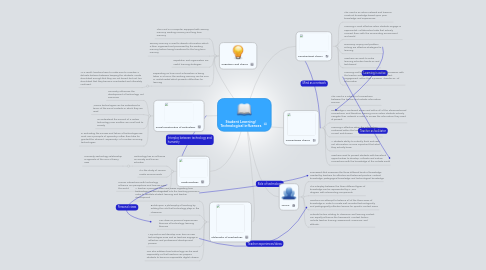Student Learning/ Technological influences
作者:Stephanie Beaver

1. Cognitive Load Theory
1.1. The mind is a computer equipped with sensory memory, working memory and long term memory
1.2. Sensory memory is used to absorb information which is then organized and processed by the working memory before being transferred to the long term memory
1.3. Repetition and organization are useful learning strategies
1.4. Depending on how much information is being taken in at once, the working memory can be over or underloaded which presents difficulties for learning
1.4.1. As a result, teachers have to make sure to maintain a delicate balance between keeping the students' minds stimulated enough that they are not bored, but not too stimulated that they become overloaded and ultimately confused.
2. Media Ecology
2.1. Technology has an influence on society and human activities
2.1.1. Humanity-Technology relationship is opposite of the SCOT theory view
2.2. It is the study of various media environments
2.3. Human interactions with technology influence our perceptions and how we view the world
3. Social Construction of Technology
3.1. Humanity influences the development of technology, not vise-versa
3.2. Various technologies can be understood in terms of the social contexts in which they are used
3.3. To understand the survival of a certain technology over another, we must look to society
3.4. In evaluating the success and failure of technologies we must use a principle of symmetry, rather than take for granted the inherent “superiority” of a certain surviving technologies.
4. Philosophy of Teachnology
4.1. A teacher's personal ideas and views regarding how technology can be integrated into the teaching process in order to facilitate student learning and teacher development
4.2. Builds upon a philosophy of teaching by adding the role that technology plays in the classroom
4.3. Can draw on personal experiences, theories of technology, learning theories
4.4. May evolve and develop over time as new technologies arise and as teachers engage in reflection and professional development process
4.5. Can also address how technology can be used responsibly, so that teachers can prepare students to become responsible digital citizens
5. Constructivist Theory
5.1. The mind is an active network and learners construct knowledge based upon prior knowledge and experiences
5.2. Learning is most effective when students engage in experiential, collaborative tasks that actively connect them with the surrounding environment and world
5.3. Discovery, inquiry and problem solving are effective strategies for learning
5.4. Teachers can work to make learning activities hands-on and task-based
5.5. Learning and teaching are both active processes, with the teacher acting as a facilitator to student engagement rather than a passive "transfer-er" of information
6. Connectivism Theory
6.1. The mind is a network of connections between the learner and outside information sources
6.2. Knowledge is contained across and within all of the aforementioned connections, and therefore learning occurs when students actively navigate their network in order to access the information they need at present
6.3. Learning is effective when the information contained within the learner's network is both current and diverse
6.4. A students ability to critically think and seek out information is more important that what they actually know
6.5. Teachers need to present students with beneficial opportunities to develop, cultivate and sustain connections with the knowledge of the outside world
7. TPACK
7.1. Framework that examines the three different kinds of knowledge needed by teachers for effective and balanced practice: content knowledge, pedagogical knowledge and technological knowledge
7.2. The interplay between the three different types of knowledge can be represented by a Venn diagram with intersecting components
7.3. Teachers can attempt to balance all of the three areas of knowledge in order to create well-rounded technologically and pedagogically effective lessons for specific content areas
7.4. Outside factors relating to classroom and learning context can equally influence the framework. Context factors include teacher training, assessment, resources, and attitude.


